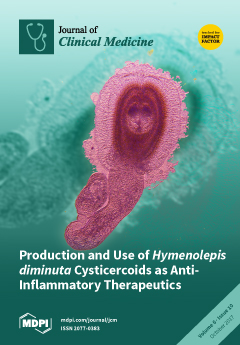Open AccessFeature PaperArticle
History and Outcome of Febrile Neutropenia Outside the Oncology Setting: A Retrospective Study of 76 Cases Related to Non-Chemotherapy Drugs
by
Emmanuel Andrès, Rachel Mourot-Cottet, Frédéric Maloisel, Olivier Keller, Thomas Vogel, François Séverac, Martine Tebacher, Jacques-Eric Gottenberg, Jean-Christophe Weber, Georges Kaltenbach, Bernard Goichot, Jean Sibilia, Anne-Sophie Korganow and Raoul Herbrecht
Cited by 3 | Viewed by 4514
Abstract
Background: Despite major advances in its prevention and treatment, febrile neutropenia remains a most concerning complication of cancer chemotherapy. Outside the oncology setting, however, only few data are currently available on febrile neutropenia related to non-chemotherapy drugs. We report here data on 76
[...] Read more.
Background: Despite major advances in its prevention and treatment, febrile neutropenia remains a most concerning complication of cancer chemotherapy. Outside the oncology setting, however, only few data are currently available on febrile neutropenia related to non-chemotherapy drugs. We report here data on 76 patients with febrile neutropenia related to non-chemotherapy drugs, followed up in a referral center within a university hospital. Patients and methods: Data from 76 patients with idiosyncratic drug-induced febrile neutropenia were retrospectively reviewed. All cases were extracted from a cohort study on agranulocytosis conducted at the Strasbourg University Hospital (Strasbourg, France). Results: Mean patient age was 52.2 years old (range: 18–93) and gender ratio (F/M) 1.6, with several comorbidities present in 86.8% of patients. The most common causative drugs were: antibiotics (37.4%), antithyroid drugs (17.2%), neuroleptic and anti-epileptic agents (13.1%), non-steroidal anti-inflammatory agents and analgesics (8%), and platelet aggregation inhibitors (8%). Main clinical presentations upon hospitalization included isolated fever (30%), sore throat, acute tonsillitis and sinusitis (18.4%), documented pneumonia (18.4%), septicemia (14.5%), and septic shock (6.6%). Mean neutrophil count at nadir was 0.13 × 10(9)/L (range: 0–0.48). While in hospital, 22 patients (28.9%) worsened clinically and required intensive care unit placement. All patients were promptly treated with broad-spectrum antibiotics, and 45 (59.2%) with hematopoietic growth factors. Mean duration of hematological recovery (neutrophil count ≥1.5 × 10(9)/L) was 7.5 days (range: 2–21), which was reduced to 0.7 days (range: 2–16) (
p = 0.089) with hematopoietic growth factors. Outcome was favorable in 89.5% of patients, whereas eight died. Conclusions: Like in oncology and myelosuppressive chemotherapy settings, idiosyncratic febrile neutropenia is typically serious, about 40% of patients exhibiting severe pneumonia, septicemia, and septic shock, with a mortality rate of 10%. Like in febrile, chemotherapy-related neutropenia, modern and timely management (immediate broad spectrum antibiotherapy, hematopoietic growth factors) may reduce infection-related mortality. All practitioners should be aware of this potential side-effect that may even occur in the event of “daily medication” exposure.
Full article






